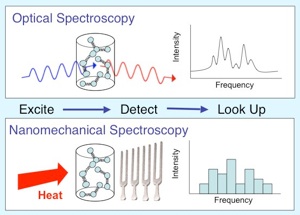Home / Research / Nanomechanical Phenomena / Sensing
Surface Stress in NanoCantilevers

We are currently performing high quality ab initio calculations to determine the origins of and contribution to the surface stresses on Au surfaces with end-functionalized alkanethiols induced by target-receptor interactions. Our calculations are aimed to providing not only a fundamental understanding of cantilever-based detection but also a guiding hand in developing better sensors. For more information on the first results in this research project please see, V. Srinivasan, G. Cicero, and J. C. Grossman, “The origin of adsorption induced surface stresses in alkanethiol-Au self-assembled Monloyers,” Physical Review Letters 101, 185504 (2008).
Nanomechanical Resonance Spectroscopy (NRS)

form of detection can be achieved; namely (1) the analyte efficiently transfers mechanical energy resonantly with the probe, (2) this energy transfer produces an experimentally measurable signal in the probe, and (3) an appropriate distribution of probe frequencies can be experimentally realized. The central idea in this approach is to take advantage of resonant exchange of mechanical energy at the nanoscale, which exploits the fact that the phonon spectrum of nanomechanical probes is commensurate with the frequency ranges of the vast majority of analytes. The basic idea has recently been published in NanoLetters [P. A. Greaney and J. C. Grossman, “Nanomechanical Resonance Spectroscopy: A Novel Route to Label-Free Ultra-Sensitive Detection,” NanoLetters 8, 2648 (2008)]. The idea has also been highlighted by several web sites such as this write-up in nanowerk. At present we are expanding upon this work to demonstrate the feasibility of NRS for a number of specific applications.
Nanomechanical



Sensing
Massachusetts Institute of Technology, 77 Massachusetts Avenue, Cambridge MA 02139-4307

